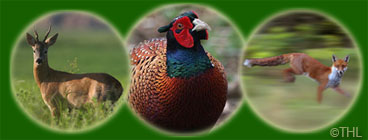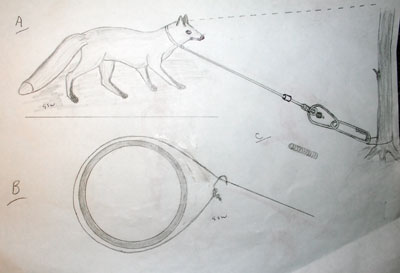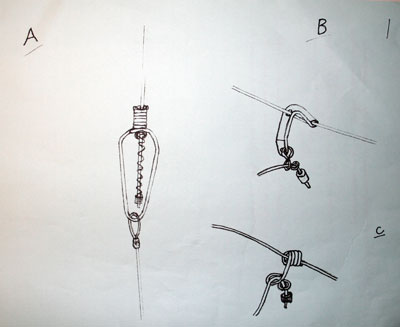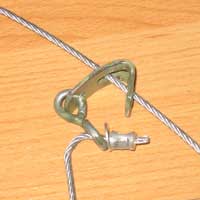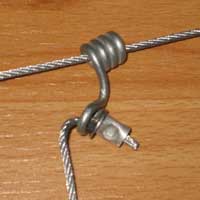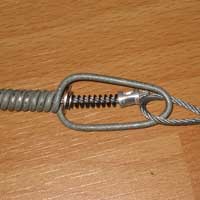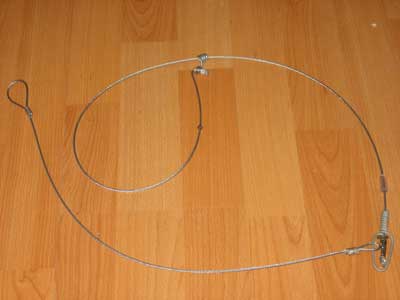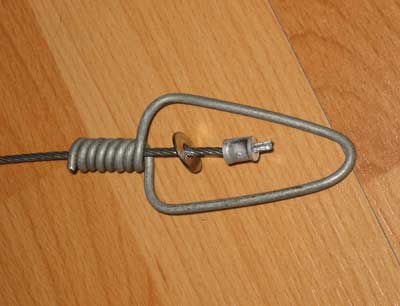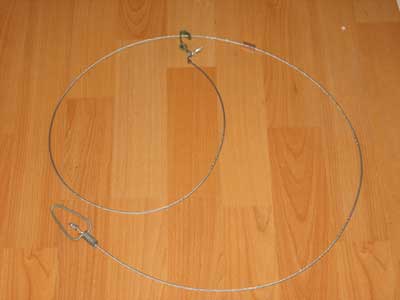Breakaway Snare
This is not a new idea by any means, the n.americans have been using this method for many years. I was the first person in the UK to start making and testing them about 12 year ago, the purpose of a breakaway snare is to allow non target species to break free, and hold the target animal, the fox, this action is attained by adding a weak link in the snare system at the base of the lock or the free running eye, there are various types I have seen and tried over the years, e.g. s.hooks, split pins, wire loops, aluminium shear pins, etc, a deer stop should also be added to a snare loop, a simple tiny 6B/A nut makes an excellent stop although I have used the ferrules from pop rivets, they have a larger circular edge to them and don't discolour unless spray painted but are eye catching & don't have the low visibility of the tiny nut which also is threaded inside, and once they are set with a slight tap of the hammer the threads grip the wire tightly and won't move, the stop nut allows the snare loop to close only so far this allows deer to pull their leg free.
The s.hook is as simple as you can get, and I have used them extensively in conjunction with the coyote sized keiper lock which has a nice 1/2" broad face and only 3/4" length & good steel and half the price of snare eyes in the uk. I drill the eye hole to 4mm which makes it a relaxing lock by using 2mm diameter aircraft cable, these snare eyes can be used year after year, as we in the uk are only allowed to use relaxing snare eyes, I found the coyote keiper snare eye and the s.hook made from english wire work extremely well retaining foxes, and allowing the non target species to escape. The heaviest fox held was 26lbs.
The G.S.W wire breakaway snare I devised also works well with the english wire and has low visibility when set in open ground. The beauty of a snare is a simple wire loop and its low cost to make, too much added clutter kills its simplicity and adds to its visibility and extra cost, another item that is unnecessary is a shock spring attached to a snare, I was the first person to incorporate them inside a wire swivel, they are normally added at or near the securing point, they are fine on footholds, to lesson the shock on heavier animals, coyotes and wolf or for catching the latter in snares with added shock springs for biological and scientific studies. They are an unnecessary addition on a fox snare they are a P.R item to look impressive as they only cause a non target animal to pull all the harder to try and escape and may not be able to do so if they are younger or a smaller species due to spring retention, increasing the power & force necessary to open the breakaway release system. Try as we may it will never be 100% effective , due to many various statistics e.g the size & weight of the various target, and non target species, as some have a steady pull and others lunge, jump and roll. When a pulling force is applied against a loop the pulling force is spread around it, including on the breakway device itself, therefore different types of breakway devices result in different forces exerted on these items. When tested or pulled on a dead weight such as log or pipe the loop shape is different and pulls on a pear shape rather than a circular loop, different conformations and shape will always affect the pulling force that is needed to activate the breakaway device, either s.hook, loop or shear pin, therefore as any trapper knows that the snare cable beds into the kneck fur, softer aircraft cable does not put as much pressure on the kneck as the hard bowden cable. Then you also have extreme weather conditions, hard freezing frost, rain & snow that cause various metals to expand & contract. This BREAKWAY SNARE SYSTEM is going to be the way forward for snaring practices in the future.
*CLICK TO ENLARGE IMAGES
Shows a fox pulling against a snare secured at the base of a tree attached to an oval quick clip ring, quick attach and release system, there is no middle inline swivel as it is not necessary for fox, any entanglement nullifies a swivels actions, in uk snares are nearly always secured near the base of a tree or with stakes or an earth anchor.
The dotted line indicates how a snare cable is secured at a higher elevation, snare cable now comes over the top of head, this helps to stop larger predator coyote/wolf biting snare cable, it also allows trapper to locate their catch in deep snow.
Shows pipe inside a snare loop, note the shape of snare loop it is pear shaped, not round as one would expect. Quarry rise to different angles and pulling force on dead objects.
Showing a shock spring incorporated into a wire centre swivel, which really is unnecessary.
Keiper coyote eye relaxing lock with breakaway s.hook showing washer and end stop.
GSW wire eye 1" long with breakaway loop incorporated into a one piece unit, made for a penny & never rusts. A fox snare can be made for 25 pence.
Click to enlarge images..
GSW break away snare shown above incorporating shock spring in swivel which is NOT needed as it causes the breakaway design to become less effective and more so with weaker non target species.
Standard snare swivel, crimp and washer.
Snare consisting of keiper style relaxing eye, and break away s.hook.
**Fox snare swivel design & s.hook.


